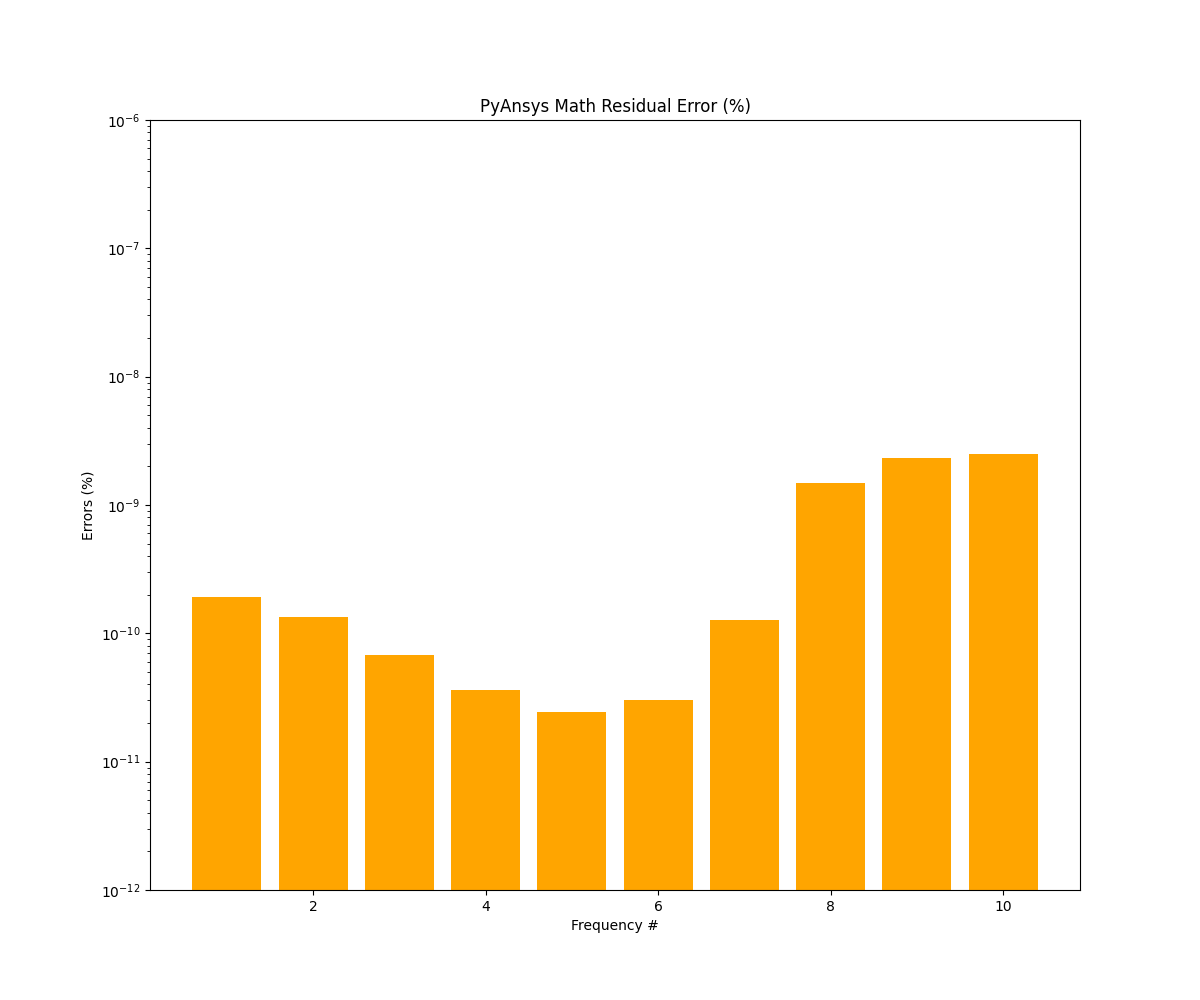Note
Go to the end to download the full example code.
Use PyAnsys Math to solve eigenproblems#
This example uses a verification manual input file, but you can use your own sparse or dense matrices.
Perform required imports and start PyAnsys#
Perform required imports.
import time
from ansys.mapdl.core.examples import vmfiles
import matplotlib.pylab as plt
import numpy as np
import ansys.math.core.math as pymath
# Start PyAnsys Math as a service.
mm = pymath.AnsMath()
Get matrices#
Run the input file from Verification Manual 153 and then
get the stiff (k) and mass (m) matrices from the FULL file.
Display size of the matrices#
Display size of the k and m matrices.
print(m.shape)
print(k.shape)
(63, 63)
(63, 63)
Allocate an array to store eigenshapes#
Allocate an array to store the eigenshapes, where nev` is the number
of eigenvalues requested,
AnsMath dense matrix (63, 10
Perform modal analysis#
Perform the modal analysis.
The algorithm is automatically chosen with respect to the properties of the matrices (such as scalar, storage, or symmetry).
Calling PyAnsys Math to solve the eigenproblem...
Elapsed time to solve this problem: 0.030763864517211914
Print eigenfrequencies#
Print the vector of eigenfrequencies.
print(ev)
KEYZBQ :
Size : 10
2.113e+02 4.865e+02 7.701e+02 1.065e+03 1.375e+03 < 5
1.517e+03 1.517e+03 1.709e+03 1.747e+03 1.747e+03 < 10
Verify the accuracy of eigenresults#
Check the residual error for the first eigenresult: \(R_1=||(K-\lambda_1.M).\phi_1||_2\)
First, compute \(\lambda_1 = \omega_1^2 = (2.\pi.f_1)^2\)
Then get the first eigenshape \(\phi_1\) and compute both \(K.\phi_1\) and \(M.\phi_1\).
# shape
phi = a[0]
# APDL command: *MULT,K,,Phi,,KPhi
kphi = k.dot(phi)
# APDL command: *MULT,M,,Phi,,MPhi
mphi = m.dot(phi)
Next, compute the \(||K.\phi_1||_2\) quantity and normalize the residual value.
# APDL command: *MULT,K,,Phi,,KPhi
kphi = k.dot(phi)
# APDL command: *NRM,KPhi,NRM2,KPhiNrm
kphinrm = kphi.norm()
Add these two vectors, using the \(\lambda_1\) scalar factor, and compute the normalized residual value: \(\frac{R_1}{||K.\phi_1||_2}\)
1.9136679485631705e-10
Compute this residual for all eigenmodes
def get_res(i):
"""Compute the residual for a given eigenmode."""
# Eigenfrequency (Hz)
f = ev[i]
# omega = 2.pi.Frequency
omega = 2 * np.pi * f
# lambda = omega^2
lam = omega * omega
# i-th eigenshape
phi = a[i]
# K.Phi
kphi = k.dot(phi)
# M.Phi
mphi = m.dot(phi)
# Normalize scalar value
kphinrm = kphi.norm()
# (K-\lambda.M).Phi
mphi *= lam
kphi -= mphi
# Return the residual
return kphi.norm() / kphinrm
pymath_acc = np.zeros(nev)
for i in range(nev):
f = ev[i]
pymath_acc[i] = get_res(i)
print(f"[{i}] : Freq = {f}\t - Residual = {pymath_acc[i]}")
[0] : Freq = 211.2534447881588 - Residual = 1.9136679485631705e-10
[1] : Freq = 486.50419022721263 - Residual = 1.3403406950622093e-10
[2] : Freq = 770.104536570519 - Residual = 6.739462952718192e-11
[3] : Freq = 1064.5432295081987 - Residual = 3.631667679775435e-11
[4] : Freq = 1374.535393913082 - Residual = 2.426773924787909e-11
[5] : Freq = 1516.8545419017319 - Residual = 3.024157834515717e-11
[6] : Freq = 1516.8545419017403 - Residual = 1.2726936409880203e-10
[7] : Freq = 1708.9655656955329 - Residual = 1.4727869229348076e-09
[8] : Freq = 1747.1764513661403 - Residual = 2.311798816791578e-09
[9] : Freq = 1747.176451366141 - Residual = 2.5094281080563296e-09
Plot accuracy of eigenresults#
Plot tahe accuracy of the eigenresults.
fig = plt.figure(figsize=(12, 10))
ax = plt.axes()
x = np.linspace(1, nev, nev)
plt.title("PyAnsys Math Residual Error (%)")
plt.yscale("log")
plt.ylim([10e-13, 10e-7])
plt.xlabel("Frequency #")
plt.ylabel("Errors (%)")
ax.bar(x, pymath_acc, label="PyAnsys Math Results", color="orange")
plt.show()

Stop PyAnsys Math#
Stop PyAnsys Math.
mm._mapdl.exit()
Total running time of the script: (0 minutes 1.473 seconds)

